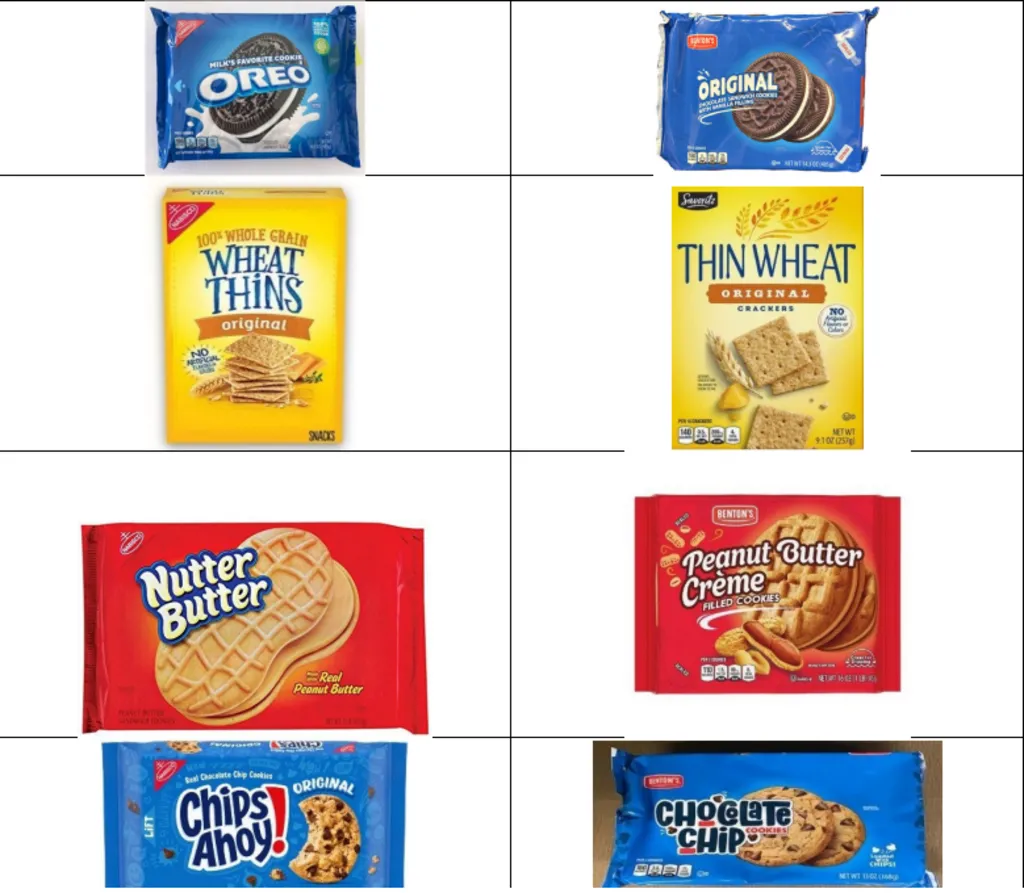iStock.com/jetcityimage
June 30, 2025
Do ALDI’s Private Labels Cross the Copycat Line?
Mondelēz filed a trademark infringement lawsuit against ALDI, alleging the packaging for ALDI’s store-brand cookies and crackers “blatantly copies” Mondelēz snack products like Chips Ahoy!, Wheat Thins, and OREO.
In a federal lawsuit filed in Illinois, Chicago-based Mondelēz said ALDI’s use of “nearly identical packaging” for similar snack items “trades upon the valuable reputation and goodwill” of multiple Mondelēz items, also including Ritz, Nilla Wafers, and Nutter Butter.
The packaging, according to court documents, is “likely to deceive and confuse consumers and dilute the distinctive quality of Mondelēz’s unique product packaging, and if not stopped, threaten to irreparably harm Mondelēz and its valuable brands.”
In the lawsuit, Mondelēz displayed side-by-side photos of the alleged “copycats” against its own snack brands, highlighting the similarities in packaging colors, fonts, and symbols. ALDI’s Thin Wheat crackers, for example, come in a gold box very similar to Mondelēz’s Wheat Thins.

Mondelēz said it contacted ALDI many times about the similar packaging but contends ALDI didn’t go far enough in making changes. Mondelēz said about ALDI, “Defendant’s business model involves an emphasis on low-priced private label products that resemble the look and feel of well-known brands.”
Mondelēz is seeking monetary damages and a court order that would stop ALDI from selling products that infringe on its trademarks. ALDI hasn’t responded to press inquiries about the lawsuit.
ALDI has a reputation for its look-alike versions of several national brands.
Mondelēz’s lawsuit follows a January case in which cider brewer Thatchers won a UK trademark infringement suit against ALDI over its lemon cider, with the UK Supreme Court later rejecting ALDI’s attempt to appeal.
Thomas Chartres-Moore, head of intellectual property at law firm Stephens Scown, told The Grocer that ALDI may have to “change its business model” since Thatchers didn’t have to prove ALDI was creating consumer confusion.
In Australia last year, ALDI lost a copyright infringement case to a maker of baby foods. Additionally, in March of this year, ALDI was sued in the UK by a fruit drinks company for allegedly copying its package design.
Speaking to Store Brands, Melanie King, an intellectual property litigator with the law firm Armstrong Teasdale, said Mondelēz only has to prove that ALDI’s packaging will result in a “likelihood of confusion” for consumers. However, she noted that ALDI could still argue that consumers expect major chains to offer a cheaper alternative to national brands.
King stated, “People who shop ALDI regularly are well aware they are not getting name-brand versions. The packaging is not telling them they are getting OREOs, for example, but the ALDI version of the product.”
Discussion Questions
Does ALDI go too far with its private label knockoffs of national brands, or is it obvious to consumers?
When does similar packaging become unfair competition?
Poll
BrainTrust
Cathy Hotka
Principal, Cathy Hotka & Associates
Carol Spieckerman
President, Spieckerman Retail
Verlin Youd
SVP Americas, Ariadne
Recent Discussions








Aldi’s private labels sometimes sail close to the line. However, it is generally clear that they are not the branded product – mostly because Aldi does not stock many national bands. And our own consumer research shows most shoppers understand the difference. Where there is direct infringement of ideas or designs, that is a more serious matter and there is a legal remedy.
The meaning of “most”, i.e. is it sufficently close to “all”, may make or break this case.
Google is now paying $300 to $500 per hour for doing work online work from home. Last paycheck of me said that $20537 from this easy and simple job. Its amazing and earns are awesome. No boss, full time freedom and earnings are in front of you. This job is just awesome. Every person can makes income online with google easily….
.
More Details For Us→→→→ https://tinyurl.com/googlejob6
There is a strong preference among consumers for ALDI’s private label products due to their affordability and quality, often finding them to be comparable to national brands. Clearly labeled products and similar packaging may indicate to shoppers that they are alternatives instead of direct copies. Transparency allows customers to make informed choices while enjoying substantial savings.
I’m an Aldi shopper, and it’s obvious which brands the Aldi products are meant to invoke. Customers aren’t confused. That said, Aldi’s actions cheapen the Mondelez brands and that may be fodder for further action.
I often get an “Oh no they didn’t!” chuckle during my visits to Aldi. If packaging mimicry is over the line, Aldi crossed it long ago. Sure, most Aldi customers get that the majority of brands in its stores are private brands. Even so, Aldi is leveraging national brands’ R&D and marketing to its benefit. Aldi is obviously sticking to the stance that it’s easier to ask for forgiveness than permission. Then again, Aldi’s looking pretty unrepentant at this point!
Hit the nail on the head. It’s a business strategy and being executed well.
The entrepreneur in me says kudos to Aldi for driving the business not only to the limit, but a bit beyond. Innovation should make people uncomfortable, in this case competitors. The brand/product manager in me says that ALDI has crossed the line, and likely should differentiate a bit more as any “reasonable” consumer can see they are running a copy-cat packaging strategy. FYI, I’m more of a LIDL shopper than ALDI when given the choice, but not really sure why…
I’m all for dupes but Wheat Thins and Thin Wheats, plus Aldi’s look-a-like packaging goes too far. Sure, shoppers know the difference between Oreos and knock-off cookies but that’s not the point. Whomever is doing package design for Aldi can do better.
The “original” is a particularly nice – or galling , depending on POV – touch.
Come on, this one is pretty easy isn’t it? ALDI makes their packages looks as close as possible to name brands for a reason. The key phrase here, of course, is “as close as possible”, which means as close as the law allows; that is a complex issue, developed over decades, and (thus) not necessarily what you or I …or logic would agree with.
Every private label is an intended knockoff of a national brand. When considering that oftentimes the national brand is also making the private label brand, then clear differentiation is no longer necessary, nor defensible.
Aldi deliberately operates in the gray area between smart competition and trademark infringement, which is part of its disruptive model that consumers have come to enjoy. There’s no consumer confusion; shoppers know they’re getting store brands. Aldi is commoditizing the visual language of CPG brands, treating package designs as public domain rather than intellectual property. Consumers process the visual cues faster and associate quality attributes despite being store brands. With package design functioning as a shorthand communication system, Aldi is borrowing the vocabulary without contributing to its development. CPG brands have created this headache by standardizing visual conventions across categories without creating distinctive and proprietary designs.
Bottom line, it appears reasonable that Aldi is deliberately mimicking the packaging designs of CPG brands and causing potential commercial harm. However, it is unlikely that consumers are confused about what they’re buying at the point of purchase. An unexpected benefit for CPG brands: forcing innovation in package designs with distinctive, defensible visual identities.
I’m all in favor of private labels creating a similar product at a lower price. It’s usually obvious when its a generic brand and can be a hit or miss. But I’ve never shopped at Aldi and a little shocked to see how similar the packaging of these “copy cats” are!
The side-by-side comparison of packaging makes a strong, visual case for a practice of closely matching the packaging graphics of leading brands. Since Aldi doesn’t sell these branded items, the packaging can be a helpful visual clue.
I’m all in favor of Aldi creating assortments that mirror what shoppers expect to find in comparable aisles at larger grocery chains. But this feels like a step too far. Retailers like Target and Walmart manage to offer private label alternatives without mimicking national brand packaging to the same extent Aldi does.
Neil Saunders rightly pointed out that Aldi carries very few national brands. Their customers aren’t expecting to find them, so it’s hard to argue that shoppers are being misled, especially since these products aren’t merchandised alongside the brands. But I think there’s a more compelling question Aldi could ask itself: does their packaging really need to be packaged so similarly to national brands?
I’d argue they’d be better served by embracing Aldi-branded packaging. The products don’t need to change—shoppers know what they’re getting—and it would allow Aldi to avoid this kind of controversy. Just my two cents.
This is silly. Does an Aldi shopper go to Aldi’s to buy Oreos? Of course not! Aldi isn’t trying to fool anyone.
I always argue that differentiation and distinction are the keys to success in retail. So I have a tough time with “copy right up to the point of not losing a court battle”. I love the way Mohamed Omer talks about “the visual language of CPG brands, treating package designs as public domain rather than intellectual property”. Beautifully said. One brand puts in the hard work of creating their own differentiation and distinction and another brand can just walk in and steal it (kind of/sort of) with no consequences? We’re just supposed to say, “How cute!”…??? Meh…shoulder shrug. No. It’s lazy. It’s wrong. Of course they are trying to tap into (steal) the visual cues the other brand has created.
I’m reminded of the aspirin or cough syrup aisle at the drug store. The private label product is on the shelf right next to the branded product. Zero % similarity in packaging. But the identical ingredients are called out. And sometimes the original brand is called out in some kind of “compare to….” language. At least that’s honest and transparent. The customer then makes an informed decision about paying a premium for the original branded product.
I get paid over 220 Dollars per hour working from home with 2 kids at home. i never thought i’d be able to do it but my best friend earns over 15k a month doing this and she convinced me to try. it was all true and has totally changed my life. This is what I do, check it out by Visiting Following Website
HERE—————⊃⫸ Www.Work44.Com
Aldi’s mimics other brands to fool the lower-income and less-educated customers they pursue. How is this acceptable to anyone?